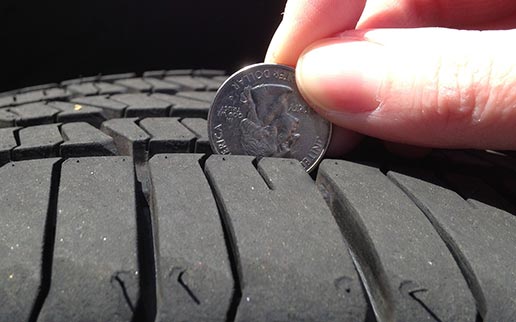
For new teen drivers, caring for your tires only takes a couple minutes.
Tire Maintenance & Tire Care
Tires are one of the most important parts of your car. After all, they are what keep you on the road. But did you know that you have to care for them on a regular basis? It’s true. New drivers tend to believe that as long as there’s gas in the car, and you change the oil when the oil light comes on, you’re fine. While engine maintenance is important, making sure that your car is riding on healthy tires is also crucial.
Inspecting Your Tires
You should perform a tire inspection once a month (if you live in a colder climate, drive long distances regularly, or drive over uneven roads, perform an inspection every two weeks). Fortunately, inspecting your tires only takes a couple minutes – so long as you know what to look for.
Wear and Tear:
You can troubleshoot most of your tires’ problems simply by looking at them. You can tell, at a glance, if they are overinflated, underinflated, or if your car is out of alignment.
- Over Inflation: If you have too much air in your tires, the middle section will bulge, and wear down faster than the sides or the edges.
- Under Inflation: If there isn’t enough air in your tire, the sides will sag, wearing down the edges much faster than the center of each tire. This is one of the most common reasons for premature tire wear.
- Poor Alignment: If your car is out of alignment, one side of each tire will wear down faster than the other.
Measuring the Tread:
Tires need tread in order to keep traction, and to keep you on the road. When driving in rain or even through a puddle, it’s the tread that prevents the water from sliding your car around.
When inspecting your tread, you want to look for depth. You may have heard about the “penny trick” as an easy way to measure the tread depth, but AAA actually suggests using a quarter for a safer measurement.
- The Quarter Trick: Simply insert a quarter, headfirst, into the tread of your tire. If you can see all of George Washington’s head, your tire tread has worn down and you need to replace it. Perform this measurement in 3 locations across the tire’s tread (outer edge, center, inner edge) in case there’s also an inflation problem.
- Spot Checking Tread: If you can see strips of worn-down rubber across your tire (spanning 2 or more treads), your tires have worn down to an unsafe tread depth and need replacing.
Things to Check While Driving
Did you also know that you can also troubleshoot problems with your tires while you’re driving?
- Thumping or Rumbling: Unusual feelings or sounds can indicate problems with your tires. A radial belt may have separated, or the tire may have been chopped, or a number or other issues. If this happens, pull over and perform the inspections above.
- Pulling: If your car pulls to one side without you turning the wheel, your wheel alignment may be off. Get this checked with your mechanic as soon as possible, as it could wind up causing you major problems down the road.
Maintaining Your Tires
Now that you know what to look for, we will show you what to do. With tires, there are a few maintenance steps you can perform by yourself, but there are some things better left to a certified mechanic.
Adjusting the Air
This may seem difficult at first, but it’s actually quite easy. Tire air is measured in pounds-per-square-inch, or PSI. You will need a tire gauge to measure the pressure (there are several different models: pen, digital, dial, or stick).
- Check the recommended pressure measurements listed on your tire
- Place your gauge onto the tire’s valve stem (press firmly)
- If the PSI reading is different from the pressure measurement on your tire, adjust accordingly.
- If adding air, check the pressure every few seconds to avoid over inflation.
- Check all tires (including your spare!)
Rotating and Balancing
Did you know that your front wheels and your back wheels perform different functions? To get the most life out of every tire, you should rotate the front and back tires. The American Automobile Association (AAA) recommends you do this every 5,000 to 7,000 miles.
Alignment
Have a mechanic perform a wheel alignment, every 12,000 miles, or whenever you feel your car is pulling to one side or the other. This will prevent unsafe steering and uneven tire wear.
Keeping your tires maintained is not only quick and easy – it keeps you safe, and can save you money.
Did this article help? SHARE it with a friend, or check out our other car maintenance articles in our RESOURCE CENTER.










